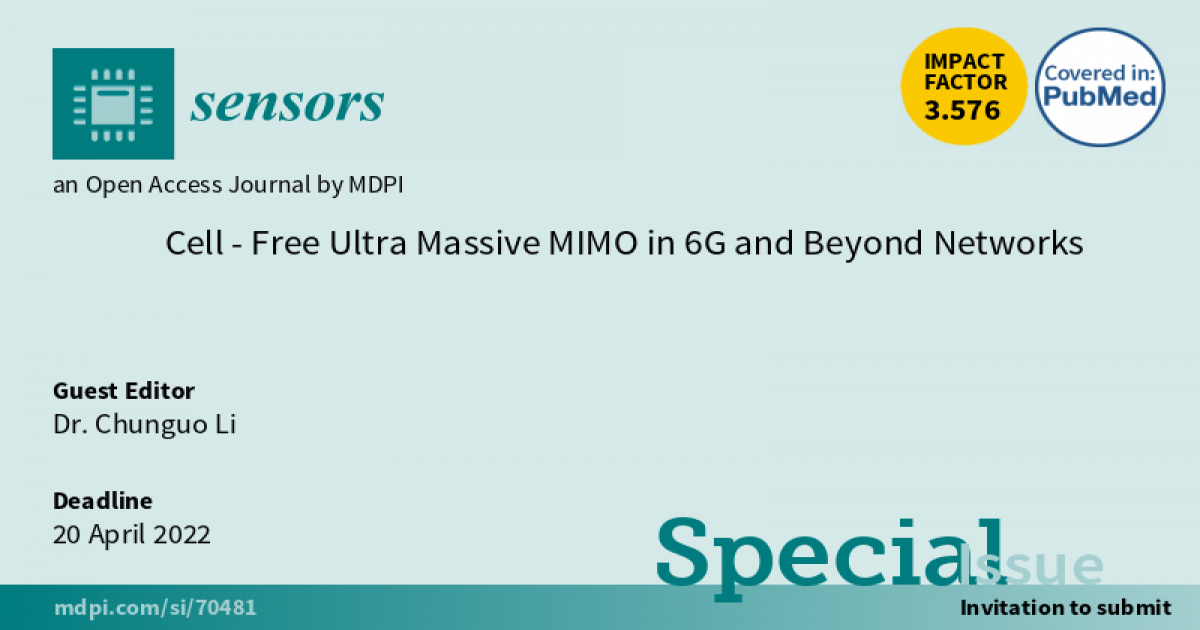Cell-Free Ultra Massive MIMO in 6G and Beyond Networks
A special issue of Sensors (ISSN 1424-8220). This special issue belongs to the section "Communications".
Deadline for manuscript submissions: closed (20 April 2022) | Viewed by 28235

Special Issue Editor
Interests: artificial intelligence-based image/video signal processing; algorithm design; wireless communications; cyberspace security theories and techniques
Special Issues, Collections and Topics in MDPI journals
Special Issue Information
Dear Colleagues,
In recent years, multiple antenna technologies have received considerable attentio from both industry and academia, given that they can provide high coverage probability, spatial multiplexing, and macroscopic diversity. To provide ubiquitous wireless connectivity and achieve orders-of-magnitude improvements in these metrics, the new paradigm shifts away from the transitional massive multiple-input multiple-output (MIMO), cell-free ultra massive MIMO and intelligent reflecting surfaces (IRSs) at the physical layer are expected to achieve this goal. This is because the cell-free ultra massive MIMO technology can effectively avoid excessive inter-cell handover, reduce the effect of detrimental shading, and depress the control signaling interaction. Furthermore, IRSs can dynamically and proactively revize the wireless transmission channel between themselves via highly controllable and intelligent signal reflection. Thus, this combination can provide a new reconfigurable environment to further enhance the wireless communication performance, and this paves the way to realizing a smart and programmable wireless environment. However, several issues must be studied and resolved in the design of practical and efficient cell-free ultra massive MIMO systems, since traditional solutions cannot be used. In this Special Issue, we are interested in high-quality submissions that mainly highlight the emerging cell-free ultra massive MIMOs for future wireless networks.
The potential topics of submissions include, but are not limited to,
- channel modeling;
- characterization;
- signal processing and estimation for B5G/6G Ultra massive MIMOs;
- cell-free massive MIMOs;
- cloud-RAN cooperative cell-free massive schemes;
- wireless communications through reconfigurable intelligent surfaces;
- AI;
- deep learning;
- machine learning for wireless communications;
- performance analysis and simulations for integrated networks;
- content caching and storage in wireless networks;
- energy-efficient and energy-harvesting PHY layer design;
- simultaneous wireless information and power transfer;
- full duplexing;
- PHY layer security and privacy;
- ultra-wideband;
- mmWave and sub-THz communication for integrated networks;
- information-theoretic aspects of wireless communications;
Dr. Chunguo Li
Guest Editor
Manuscript Submission Information
Manuscripts should be submitted online at www.mdpi.com by registering and logging in to this website. Once you are registered, click here to go to the submission form. Manuscripts can be submitted until the deadline. All submissions that pass pre-check are peer-reviewed. Accepted papers will be published continuously in the journal (as soon as accepted) and will be listed together on the special issue website. Research articles, review articles as well as short communications are invited. For planned papers, a title and short abstract (about 100 words) can be sent to the Editorial Office for announcement on this website.
Submitted manuscripts should not have been published previously, nor be under consideration for publication elsewhere (except conference proceedings papers). All manuscripts are thoroughly refereed through a single-blind peer-review process. A guide for authors and other relevant information for submission of manuscripts is available on the Instructions for Authors page. Sensors is an international peer-reviewed open access semimonthly journal published by MDPI.
Please visit the Instructions for Authors page before submitting a manuscript. The Article Processing Charge (APC) for publication in this open access journal is 2600 CHF (Swiss Francs). Submitted papers should be well formatted and use good English. Authors may use MDPI's English editing service prior to publication or during author revisions.
Keywords
- ultra massive MIMO
- cell-free massive MIMO
- cloud-RAN
Benefits of Publishing in a Special Issue
- Ease of navigation: Grouping papers by topic helps scholars navigate broad scope journals more efficiently.
- Greater discoverability: Special Issues support the reach and impact of scientific research. Articles in Special Issues are more discoverable and cited more frequently.
- Expansion of research network: Special Issues facilitate connections among authors, fostering scientific collaborations.
- External promotion: Articles in Special Issues are often promoted through the journal's social media, increasing their visibility.
- Reprint: MDPI Books provides the opportunity to republish successful Special Issues in book format, both online and in print.
Further information on MDPI's Special Issue policies can be found here.






